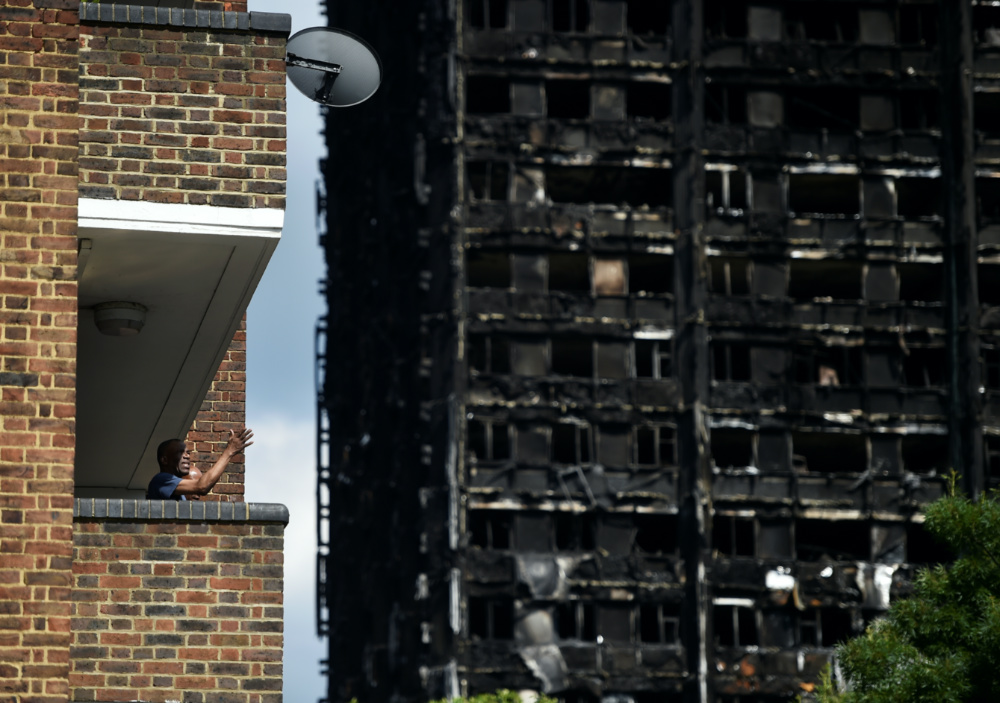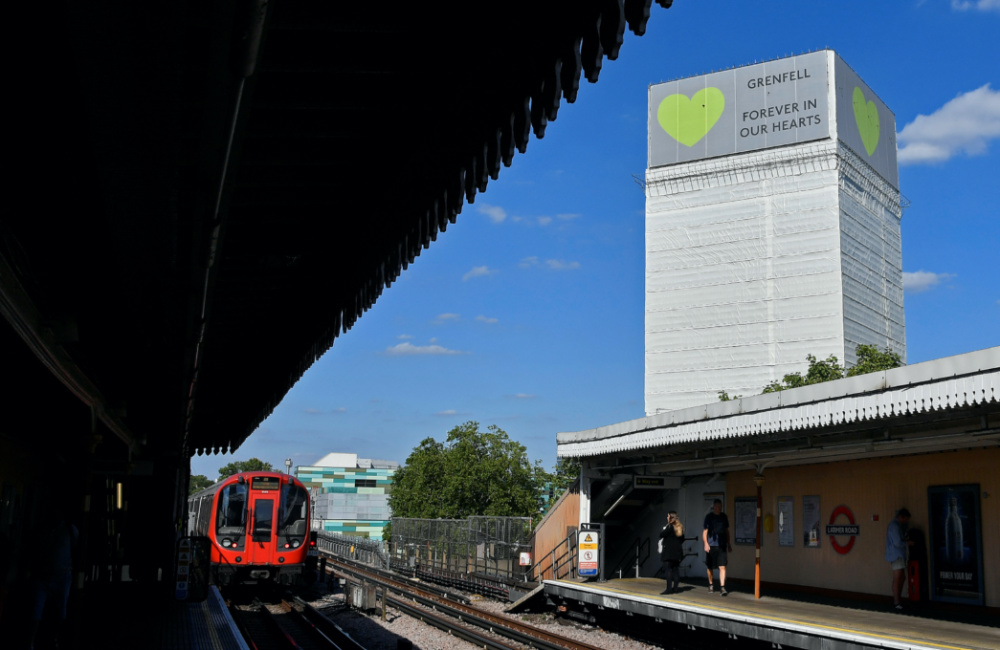
ZOE TABARY, of Thomson Reuters Foundation, reports on how homeowners are facing bankrupcy and homelessness due to the cost of replacing exterior building panels in the wake of the deadly 2017 fire at London’s Grenfell housing block…
London, UK
Thomson Reuters Foundation
When single mother Timea scraped together enough money to buy a two-bedroom flat in London, she looked forward to providing her son with the security of their own home.
But two years later, Timea and thousands of other homeowners in Britain face bankruptcy and homelessness due to the cost of replacing exterior building panels ruled unsafe after a deadly 2017 fire at London’s Grenfell housing block, campaigners said.

A man stands on his balcony in front of the burnt out shell of the Grenfell apartment tower block in North Kensington, London, Britain, on 17th June, 2017. PICTURE: Reuters/Hannah McKay/File photo.
Leaseholders in Timea’s housing development in south-east London will have to pay £13 million to remove the cladding panels, which were used widely to improve buildings’ aesthetics and energy efficiency.
That amounts to £35,000 per flat on average, Timea said, although the cost will vary depending on the size of each unit.
“I used all my savings to buy this flat…Now I’m stuck between a rock and a hard place. I can’t afford the extra service charge or any further bills to remove cladding but if I don’t pay, they can take me to tribunal and terminate my lease.”
– Timea, a single mother speaking about the impact of the costs of ensuring her home meets new standards.
“I used all my savings to buy this flat,” she told the Thomson Reuters Foundation, adding that neither the building’s management company nor the social housing association that owns 65 per cent of her flat had told her about any fire safety issues.
“Now I’m stuck between a rock and a hard place. I can’t afford the extra service charge or any further bills to remove cladding but if I don’t pay, they can take me to tribunal and terminate my lease,” she said in a phone interview.
Timea has already had to stretch her income as a complaints investigator in financial regulation to pay the service charge on her flat, which has nearly doubled to £450 per month.
About 700,000 people in England live in buildings with flammable exterior cladding similar to that used at Grenfell Tower, according to the End Our Cladding Scandal campaign.
A fire tore through the 23-storey block, owned by the wealthy west London borough of Kensington and Chelsea, in June, 2017, killing 72 people in Britain’s worst blaze in a residential building since World War II.
The government announced in March a £1 billion fund to remove unsafe cladding from housing buildings that are at least 18 metres tall, but that will only cover about a third of the total cost, Britain’s Public Accounts Committee said.
The issue has also rendered up to 1.5 million flats unsellable because their owners cannot demonstrate the safety of their cladding and insulation – a new requirement among mortgage lenders, said Jennifer Reid, an EOCS campaign spokeswoman.
“Many flats affected by this crisis are valued at zero so it’s hard for people to raise funds against them,” she said. “So there’s a likelihood that many people will get themselves into serious debt, face bankruptcy and losing their homes.”

The scaffold clad Grenfell Tower is seen from Latimer Road tube station in London, Britain, on 2nd August, 2018. REUTERS/Toby Melville /File photo.
Research published in June by the UK Cladding Action Group, which represents residents in unsafe buildings, found one in five leaseholders embroiled in cladding issues have had suicidal thoughts or felt a desire to self-harm.
The coronavirus pandemic has already strained the income of millions of Britons, with the Bank of England forecasting unemployment to rise to about 2.5 million by year-end.
Timea, who only gave her first name to protect her identity from an abusive former partner, said she would struggle to find another job in financial regulation – her current contract ends this month – if she went bankrupt.
“The possibility of a fire is not even the biggest issue here,” she said. “The legacy of Grenfell is going to be hundreds of thousands of people being made bankrupt and homeless.”
Rendall & Rittner, the company that manages Timea’s building, said the cost of installing an interim 24/7 fire watch and a fire alarm were not covered by the government’s Building Safety Fund, so had to be passed on to leaseholders.
“[The company] continues to seek ways of mitigating the cost to our residents…and has been communicating regularly with leaseholders”, a spokeswoman said in emailed comments.
A spokesman for Optivo, the housing association that part-owns Timea’s apartment in a shared-ownership scheme, said “the investigations, interim measures to keep residents safe and remedial works come at a huge cost”.
“I’ve used all up all of my savings to pay for the [fire] watch. Once we get the bill for the cladding, I don’t know what I’ll do, I’ve heard it could be up to £80,000 per flat.”
– Rachael Loftus, who lives in a seven storey block in Leeds.
Rachael Loftus, who works for the National Health Service, has had to pay £12,000 on interim fire safety measures for the seven storey block where she lives in the northern city of Leeds, including a 24/7 watch and new alarm.
“I’ve used all up all of my savings to pay for the [fire] watch,” she said in a phone interview. “Once we get the bill for the cladding, I don’t know what I’ll do, I’ve heard it could be up to £80,000 per flat.”
She said her two-bedroom apartment is currently valued at zero due to the building’s various safety risks, and no bank will allow her to remortgage or get a loan to meet the cost of removing the cladding.
Building owners should be responsible for ensuring the safety of the properties and their residents, the government’s housing ministry said.
“We expect them to meet remediation costs without passing them on to leaseholders,” a ministry spokeswoman said.
She highlighted progress on making the country’s houses safer, saying work had been completed or was underway in more than 70 per cent of buildings with ACM (aluminium composite material) cladding. In the social housing sector, it has reached 90 per cent.
Loftus, the NHS employee in Leeds, said the pandemic has put her and her neighbours at higher risk of a fire.
“We’re all working from home now so spending more time in the building, which increases the risk of accident.”
It took “a lot of persistence” to get the building’s management company – Centrick Limited – to respond to fire safety concerns, she added.
“It doesn’t feel as though their focus is on our safety, just on us paying the bills,” she said.
Neither Centrick Limited nor the freeholder, Residents Quarter Limited, responded to requests for comment.
“I can’t sell it [the flat], I can’t sublet, even if I left tomorrow I’d still be responsible for all the bills,” Loftus said. “There’s literally no way out of this.”





